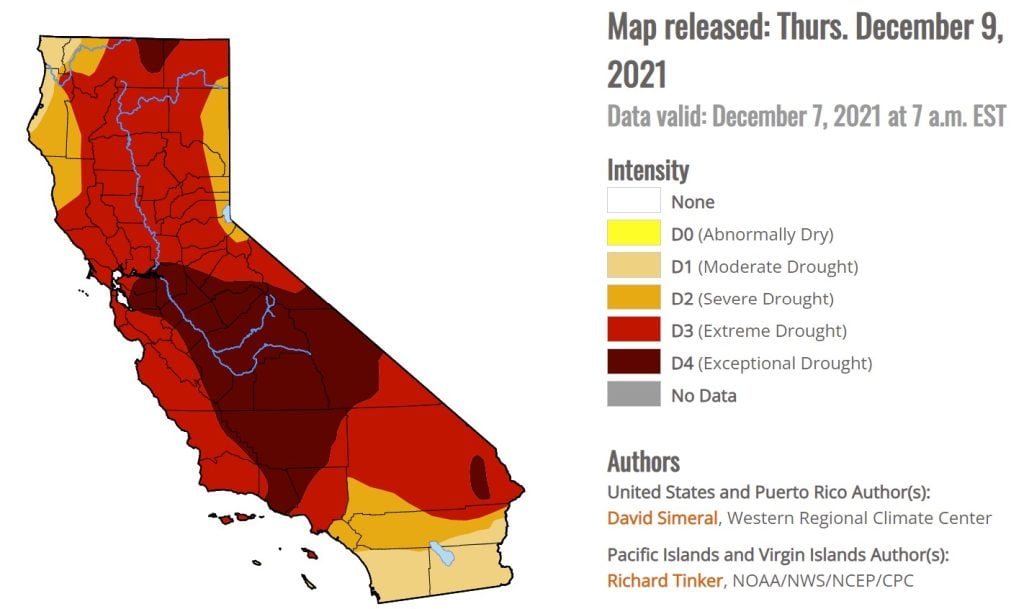
More than 80% of California is in one of the two most severe categories of drought, as shown by the darker colors on the above map. No region has escaped the drought.
California is preparing for a third straight year of drought, and officials are tightening limits on water use to levels never seen so early in the water year.
Most of the state’s water reservoirs are well below average, with several at less than a third of their capacity.
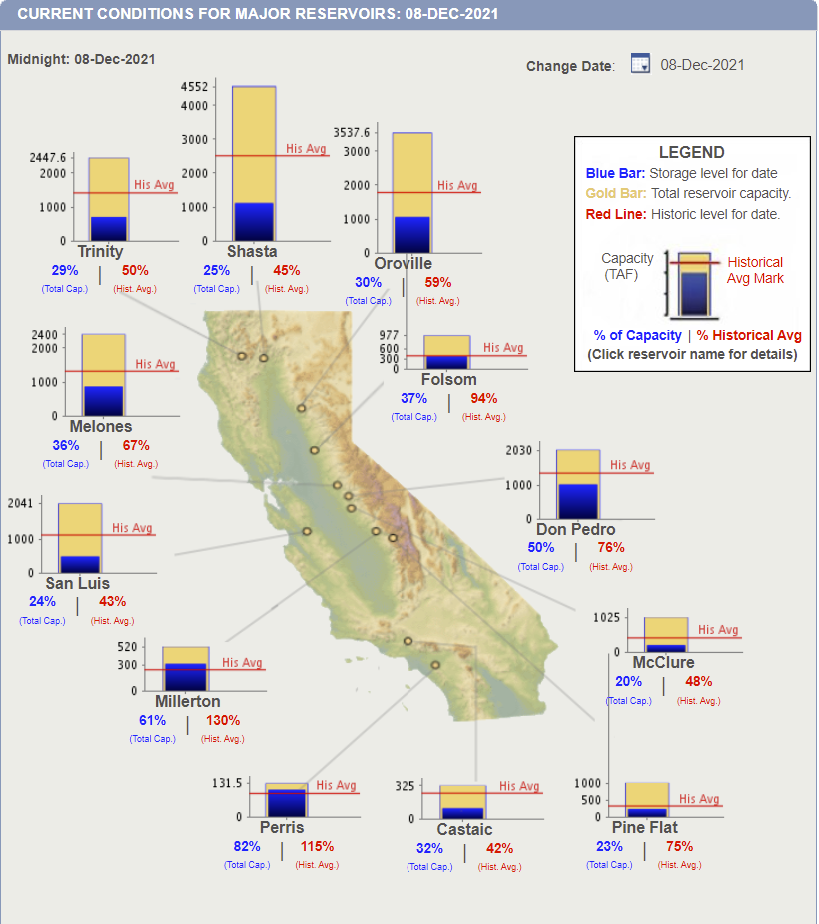
The outlook for rain and snow this winter, when most of the state’s yearly precipitation arrives, isn’t promising.
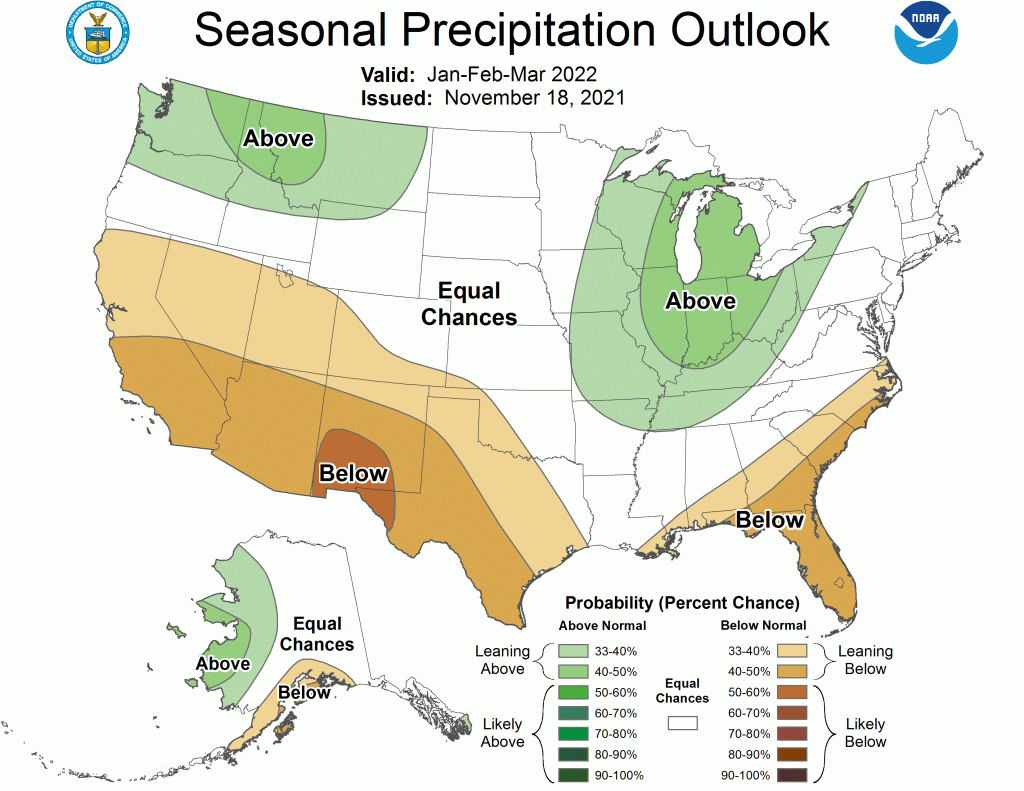
Especially worrying is the outlook for the Sierra Nevada, the long mountain chain that runs through the eastern part of the state. California’s cities and its farms—which grow over a third of the nation’s vegetables and two-thirds of its fruit and nuts—rely on runoff from the mountains’ snowpack for water.
A closer look at California’s water resources shows the challenge ahead and how hot/dry cycles is putting the state’s water supply and agriculture at greater risk.
Where California gets its water?
Statewide, California averages about 2 feet of precipitation a year, about two-thirds of the global average, giving the state as a whole a semiarid climate.
The majority of California’s rain and snow falls in the mountains, primarily in winter and spring. But agriculture and coastal cities need that water to get through the dry summers.
To get water to dry Southern California and help with flood control in the north, California over the past century developed a statewide system of reservoirs, tunnels and canals that brings water from the mountains.
The largest of those projects, the State Water Project, delivers water from the higher-precipitation northern Sierra to the southern half of the state.
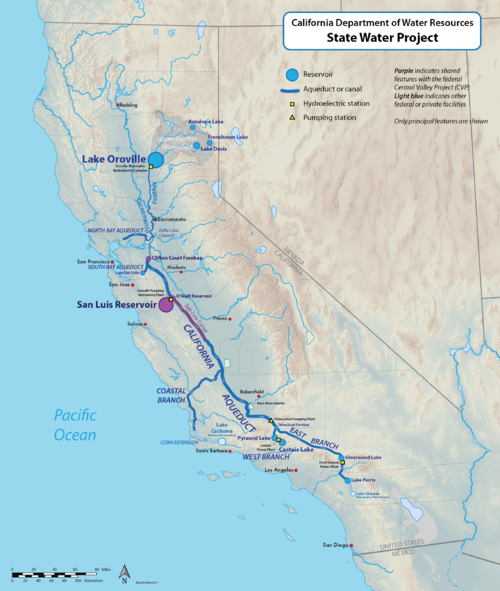
To track where the water goes, it’s useful to look at the volume in acre-feet. California is about 100 million acres in area, so at 2 feet a year, its annual precipitation averages about 200 million acre-feet.
Of that 200, an average of only about 80 million acre-feet heads downstream. Much of the water returns to the atmosphere through evapotranspiration by plants and trees in the Sierra Nevada or North Coast forests.
Of the 80 million acre-feet that does run off, about half remains in the aquatic environment, such as rivers flowing to the ocean.
That leaves about 41 million acre-feet for downstream use. About 80% of that goes for agriculture and 20% for urban uses.
In wet years, there may be much more than 80 million acre-feet of water available, but in dry years, it can be much less.
In 2020, for example, California’s precipitation was less than two-thirds of average, and the State Water Project delivered only 5% of the contracted amounts. The state’s other main aqueduct systems that move water around the state also severely reduced their supplies.
2021 water year one of the three driest on record
The 2021 water year, which ended Sept. 30, was one of the three driest on record for the Sierra Nevada. Precipitation was about 44% of average.
With limited precipitation as of December 2021 and the state in extreme drought, the State Water Project cut its preliminary allocations for water agencies to 0% for 2022, with small amounts still flowing for health and safety needs.
Updated Drought Monitor released Dec 2nd. pic.twitter.com/9KoAPZy5rf
— NWS Bay Area (@NWSBayArea) December 3, 2021
While conditions could improve if more storms come in the next three months, the official National Oceanic and Atmospheric Administration outlook points to below-normal precipitation being more likely than above normal.
Drought and a warming climate
Multiyear dry periods, when annual precipitation is below average, are a feature of California’s climate, but rising global temperatures are also having an impact.
Over the past 1,100 years, there has been at least one dry period lasting four years or longer each century. There have been two in the past 35 years—1987-92 and 2012-15. A warmer climate intensifies the effect of these dry periods, as drier soil and drier air stress both natural vegetation and crops.
Rising global temperatures affect runoff from the Sierra Nevada, which provides over 60% of California’s developed water supply.
Over 80% of the runoff in the central and southern Sierra Nevada comes from the snow zone. In the wetter but lower-elevation northern Sierra, rainfall contributes over one-third of the annual runoff.
The average snowline, the elevation above which most precipitation is snow, goes from about 5,000 feet elevation in the north to 7,000 feet in the south. On average, each 1.8 degrees Fahrenheit (1 Celsius) of warming could push the snowline another 500 feet higher, reducing the snow total.
Shifts from snow to rain and earlier runoff also mean that more of the capacity behind existing dams will be allocated to flood control, further reducing their capacity for seasonal water-supply storage.
A wealth of research has established that the Sierra Nevada could see low- to no-snow winters for years at a time by the late 2040s if the climate cycles continue warming.
Warming will also increase water demand from forests as growing seasons lengthen and drive both drought stress leading to tree mortality and increased risk of high-severity wildfires.
Sustainability in a warming climate
Water storage is central to California’s water security.
Communities and farms can pump more groundwater when supplies are low, but the state has been pumping out more water than is replenished in wet years.
Parts of the state rely on water from the Colorado River, whose dams provide for several years of water storage, but the basin lacks the runoff to fill the dams.
Public opposition has made it difficult to build new dams, so better use of groundwater for both seasonal and multiyear storage is crucial.
A great documentary about the coming WATER WARS!
Trailer – Megadrought: The Annihilation of the Human Race Accelerates from GenSix Productions on Vimeo.
The state’s Sustainable Groundwater Management Act requires local agencies to develop sustainability plans. That provides some hope that groundwater pumping and replenishment can be brought into balance, most likely by leaving some cropland unplanted. Managed aquifer recharge south of the Sacramento-San Joaquin Delta is gradually expanding, and much more can be done.
If the state doesn’t do more, including tactics such as applying desalination technology to make saltwater usable, urban areas can expect the 25% cuts in water use put in place during the 2012-15 drought to be more common and potentially even deeper.
California’s water resources can provide for a healthy environment, robust economy and sustainable agricultural use. Achieving this will require upgrading both natural infrastructure—headwaters forests, floodplains and groundwater recharge in agricultural areas—and built infrastructure, such as canals, spillways and levees. The information is available; officials now have to follow through.
Powerful storm this weekend
A powerful storm swirling in the Pacific Ocean is poised to bring much-needed rain and snow this weekend to drought-stricken California.
Up to 12 inches (30 centimeters) of snow is expected to fall in the Sierra Nevada Mountains starting Saturday, and 2 inches of rain will drench the Sacramento area, according to the National Weather Service. The storm could be intense enough to disrupt travel on roads at higher elevations.
While some rain, mountain #snow will fall in California through Thursday, a more significant soaking is looking more likely for several days early next week.
Not as extreme an atmospheric river as October, but periods of heavy rain, heavy mountain snow are likely. pic.twitter.com/7TzmJ79Kca
— Jonathan Erdman (@wxjerdman) December 7, 2021
“It could be a significant winter storm for us,” Eric Kurth, a National Weather Service meteorologist in Sacramento. “We’re expecting a good potential for travel disruptions over the mountains.”
The rain and snow arrive at a crucial moment for the state. Drought has gripped every inch of California for more than six months. Any relief is apt to come during the winter rainy season. Snow is especially critical because it will stay in the mountains until spring, then flow down to feed reservoirs used for drinking and agriculture.
Cold Alaskan air to arrive into California next week and combine with moisture from Pacific cold front / atmospheric river.
Heavy rain and snow to accumulate.
Chilly at sea level, but probably just a few degrees too warm for wintry precip in San Fran or Monterey pic.twitter.com/uunEeCNkmf— Ryan | Forecast (@RyanMaue) December 8, 2021
“This is the time of year that we start building up the snow pack,” Kurth said. “It is a frozen reservoir.”
The looming storm has characteristics of an atmospheric river, which are powerful streams of moisture that flow off the Pacific carrying as much water through the air as in the mouth of the Mississippi River. A similar system brought widespread flooding across British Columbia in Canada last month.
Meteorologists rank atmospheric rivers on a scale of 1 to 5 — similar to the Saffir-Simpson scale used for hurricanes — with 5 being the most powerful. This weekend’s system is forecast to peak as a category 3 along the coast north of the Bay Area, according to the Center for Western Weather and Water Extremes.
For us in California bring out your coats, below freezing temperatures expected in the valley in the coming days. ? Then an atmospheric river following with storm after storm. #CAwx #WxTwitter https://t.co/re7TCfxTtA
— Ronald Martinez ? (@CAStormLover) December 7, 2021
China’s southern megacities warn of water shortages
China’s major southern cities Guangzhou and Shenzhen have warned of severe water shortages lasting into next spring as the East River, a tributary of Guangdong’s Pearl River, continues to be hit by its most severe drought in decades.
Authorities in both cities are asking citizens to reduce water consumption, with rainfall between January to October this year down by a quarter compared to average levels over the last decade, according to the Guangzhou government.
The inflow of water into the East River Basin, a major supply of water for both cities, will remain at around 50-60% its usual level into next spring, according to an official notice on Monday.
The company in charge of Guangzhou’s water supply is taking emergency measures to deal with increased salt tides, where the water supply becomes increasingly saline due to a lack of fresh water, it said on Wednesday.
Hong Kong also imports much of its water from the East River.
Water is the most important commodity and means life, food, weather ! As water begins to disappear, wars will spread across the world. [Conversation, Bloomberg, Yahoo]
Now subscribe to this blog to get more amazing news curated just for you right in your inbox on a daily basis (here an example of our new newsletter).
You can also follow us on Facebook and/ or Twitter. And, by the way you can also make a donation through Paypal. Thank you!
You should really subscribe to QFiles. You will get very interesting information about strange events around the world.











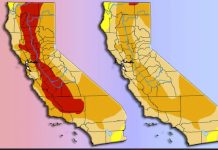
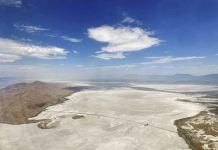

you’re probably right on that .50cal
agree100% .50cal…. the politicians and media are full of crap! just 2 yrs ago they had to release water out of the feather river project, oroville etc.. as it was about crest… we have many reservoirs and should have had more if the money that was allocated to build them was used…. they show old pics of low water levels… so corrupt and they push FEAR!
We are due 90% of rain tonight around 2300hrs. The map area for my state is mustard colored. I’ve been here going on seven years. This crisis seems concocted, and stats are spun for grant money in the new world of scientific disorder.
Nature will balance out what people need, with God’s Blessing. However, the way our country is acting, I find it very hard to believe God will bless America. In fact, I expect severe punishment from God Almighty in terms of cataclysmic events.
Especially areas with sodomy, abortion, drunkenness, perverting kids, porno industry. I’ve never seen it so bad in all my years. All I can do is pray, and read the Bible — much more the last few years. I wasn’t as serious in my youth. Now, I am convinced. The Lord saved me, and I know it.
Merry Christmas